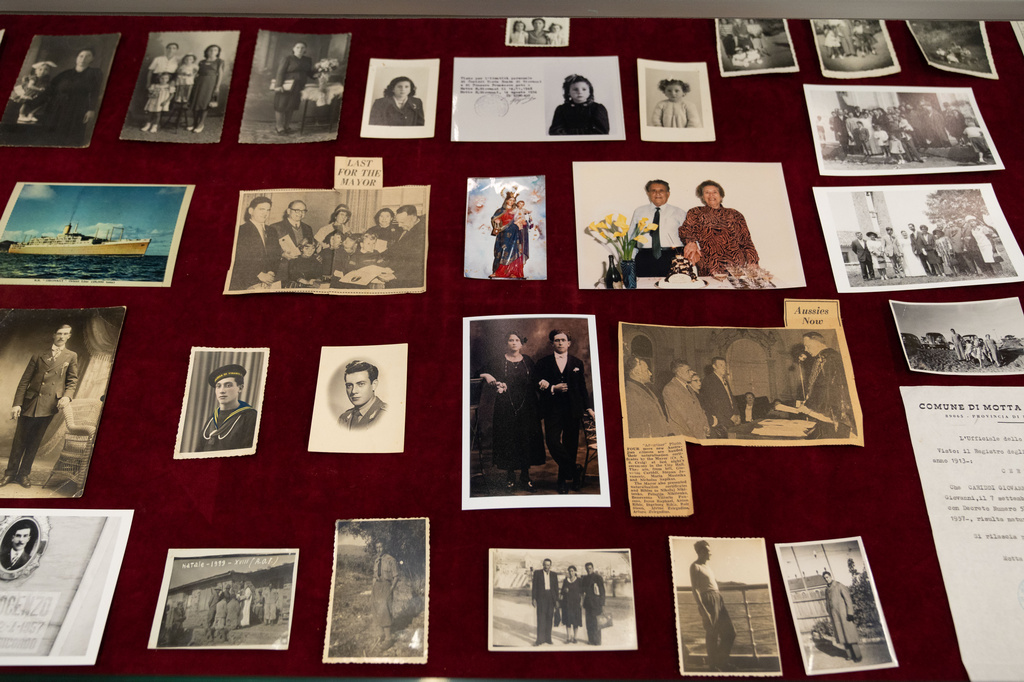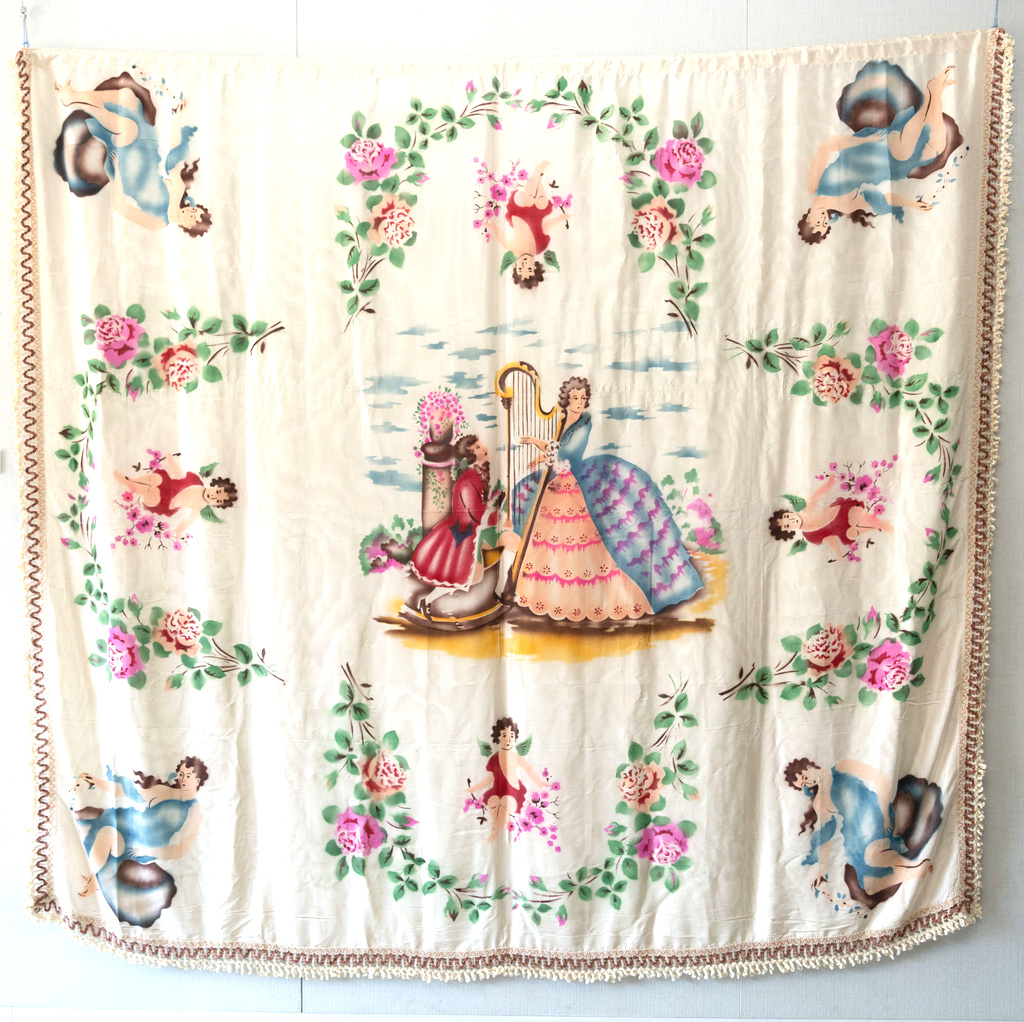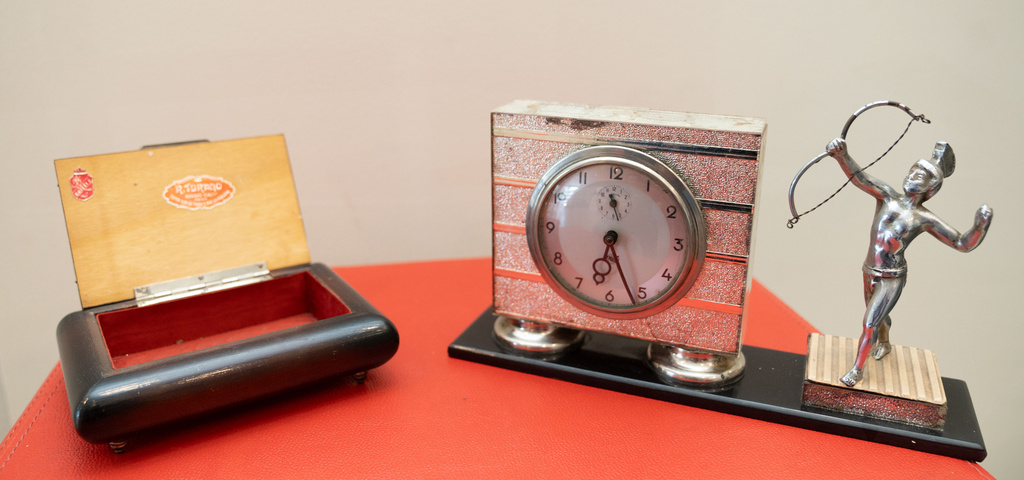Lella Cariddi gathers the material history of her Italian forebears in honour of their journey across the world.
In 2024, I was one of five Italian-Australian artists invited to participate in the ethnographic, multigenerational exhibition titled: “Memories That Make Us- Home Is a Distant Shore: Stories of Post World War Two, Italian Migration to Australia” – Proudly presented by CO. AS. IT. Italian Assistance Association, in partnership with Deakin University.
The circumstances which motivated our father, Giovanni Cariddi, to leave our large extended family and all he knew in our hometown of Motta San Giovanni, on the toe of Italy, to migrate to Australia, are linked to World War II. From 1939 to 1947, our father was in North-East Africa. For more than six of those years, he was a prisoner of war in Kenya.
Being born after my father joined the Italian Army, we first met when he was repatriated in 1947. After a short recovery period at home, he left again to work in northern Italy, returning home once a year at Christmas. In 1950, when he moved to Australia, it took him five years to save the money to buy the tickets for our sea passage from Naples to Melbourne, on the SS Oronsay. By the time we were united as a family in 1955, I was fifteen-and-three-quarters, my sister Maria six-and-a-half, and my sister Sally was four-and-a-half years of age when she met our father for the very first time.
I invited both my sisters and visual artist Liliana Barbieri to assist me with the selection of artefacts for a wall installation and two installations in vitrines. These represent our family’s migration story and our mother’s ingenuity, creativity, and connections.
The wall installation features: 1. A seven-minute documentary. 2. A bilingual panel (English/Italian) titled: “While our mother waited”, in homage of our mother’s resilience during our father’s long absences. 3. An ivory-coloured bedspread, colourfully decorated in rococo style with stencil painted cherubs and courting lovers in the centre, which our mother bought for my trousseau when I was still in primary school.
- Fine cotton bedsheet, intricately hand-embroidered by our mother in Italy, during the 1930s.
- Ivory-coloured bedspread, decorated in rococo style with stencil painted cherubs and courting lovers in the centre, which our mother bought for my trousseau when I was still in primary school. C.1951
- Mantle clock and jewellery box, given to our mother as parting gifts. C.1955
- Our father Giovanni, as a five-year-old, in an outfit that his father had sent from New York. C.1917
Up to the 1980s, in southern Italy, the dowry, “dota,” was an essential part of the marriage tradition. It served as a formal contract between families. If the bride’s family were from the moneyed elite, they’d give their daughter landholdings or a house. While the less well-off put together a trousseau of “biancheria” for the future bride, which consisted of: petticoats and other intimate under-garments; sheets and pillowcases; tablecloths and serviettes; cushion covers and loom-woven towels. All were home-made and embroidered by hand. And bedspreads, some crocheted and some bought. They were all in half-dozen lots, stored in a treasure-chest “baule”, lined with taffeta.
The installation in vitrine one features: 1. A much treasured fine cotton bedsheet, intricately hand-embroidered across the top edge, by our mother in Italy during the 1930s, using the drawn thread technique to give form to delicate white-on-white cherubs and flowers. Sally fondly remembers that when one of us came down with a childhood illness, in preparation for the doctor’s home visit, our mother would put us in her double bed, dressed with this sheet.
- A red felt hat that our mother had made-to-measure for me when I was three.
- An assortment of airmail letters and embossed vellum cards from family and friends, which were a source of spiritual sustenance for our parents.
- A studio photo of our father as a five-year-old, in an outfit that his father had sent from New York.
- Our father’s Morse code operator wartime medals, and membership card.
- The elegant pigeon-grey shoes our mother wore when she disembarked.
- The teak elephant with ivory tusks, which our mother bought for Sally, in Colombo.
- A mantle clock and a jewellery box, given to our mother as parting gifts, which she kept on her dressing-table.
Our mother was the third daughter in a family of six surviving children (four daughters and two sons). The sons in the family heroically travelled far from their hometown, in search of paid work. But to protect the daughter’s chastity, none of the girls in my mother’s family worked outside the home. By day, they tended to the family’s small land holdings. In wintertime, they harvested olives. The ripe olives were scalded and seasoned with herbs to be eaten with fresh, crusty bread. The firm ones were crushed to produce olive oil. In summer, they sharpened sickles to cut and bundle up wheat stalks, which were threshed to separate the straw from the grain, which would be milled into flour. They bagged white mulberry leaves to feed the silkworms that produced silk yarn, with which they crafted elegant garments. They skinned & sun-dried prickly pears for the winter pantry. Smoked the bees out of their hives to collect fresh honey. And at night, they worked on each other’s trousseau, aided by the light of an oil lamp.
Priority for acquiring a daughter’s trousseau was given to the eldest, followed by the others according to seniority. Our mother was in her late twenties, before her family could afford to buy her trousseau. Tradition, craft, pride, memory, and displacement coalesce in our mother’s much loved, bedsheet.
The installation in vitrine two features an assortment of multigenerational photographs from our paternal and maternal families, including one of our Aunt Nina and uncle Michele Triolo, who sponsored our father to come to Australia.
Sandra Shotlander, who visited the exhibition, wrote:
These stories of people like yourself and your family, of survival, of courage, of loss, and adaption to a foreign land are also part of our history and it is so important for them to be told. I found the combination of video, writing, photos and the objects on display deeply affecting.
The artefacts you have chosen for the story of your family, painted a picture for me of your mother, wearing those elegant Italian shoes, as she crossed the ocean to come here with you and your sisters. The lace work on the cotton sheet she had embroidered, was so delicately done.
The way the bedspread she bought for your trousseau, with the romantic scene of a man and woman from the 1700’s or 1800’s in the centre and Cupids at each corner, hung in the exhibition, could have been a romantic painting. And your red felt hat with the turned- up brim and faded grosgrain ribbon, somehow created a presence traversing all these stories.
Italian textiles were also very much appreciated by our Australian-born cousin Nina. Nina’s daughter Antonia Mullaly sent me an article from the Bendigo Advertiser of 19 November 1962, which reads: “Veil From Italy. ” The waist-length tulle veil, Chantilly lace, and white pure silk that made the gown worn by Nina Triolo for her marriage with Peter Thomas Mullaly were sent from Italy by the bride’s mother’s family.
✿
The Memories That Make Us exhibition, on display at MUSEO Italiano, 199 Faraday Street, Carlton, until 14 June 2025, is offered to the public within CO.AS.IT.’s Cultural Program, which has a broad diasporic focus. The foundational position of migrant memories within this cultural program is evident in both this exhibition of disparate threads which together weave the fabric of migration, and the award – winning documentary, titled: “Memories That Make Us: Stories of Post World War Two Italian Migration to Australia “(Martin Potter, 2021), also the fruit of a collaboration between CO.AS.IT. and Deakin University.
Photos by Adam Ricco
About Lella Cariddi
 Lella Cariddi OAM is an Italian-born Australian writer, curator, and community arts practitioner renowned for her work in documenting and celebrating migrant stories and multicultural histories in Australia. Arriving in Australia in 1955, she has spent decades researching and curating multidisciplinary projects that explore the experiences of migration, identity, and belonging. Cariddi’s practice spans writing, curating exhibitions, producing community arts events, and creating short-form social history documentaries. Her work is widely recognised for its contribution to cultural diversity and social inclusion, and she has been honoured with awards such as the Order of Australia Medal for her significant service to the arts and multicultural communities.
Lella Cariddi OAM is an Italian-born Australian writer, curator, and community arts practitioner renowned for her work in documenting and celebrating migrant stories and multicultural histories in Australia. Arriving in Australia in 1955, she has spent decades researching and curating multidisciplinary projects that explore the experiences of migration, identity, and belonging. Cariddi’s practice spans writing, curating exhibitions, producing community arts events, and creating short-form social history documentaries. Her work is widely recognised for its contribution to cultural diversity and social inclusion, and she has been honoured with awards such as the Order of Australia Medal for her significant service to the arts and multicultural communities.







Comments
A garland of congratulations to Kevin Murray and his team for weaving and distributing a slate of uniquely rich and moving complimentary threads, which will enable me to create global connections. I am interested to connect in particular with other contributors to Garland magazine, who have left their birthplace not of their own choosing.
I know that when I re-read each story and savour it’s cultural significance, I will be the richer for it.
I live in Melbourne, Victoria Australia, which in the language of First Nation people, the name for Melbourne is “Naarm”.
While I have been living in Australian for 70 years, the fact that I live in a colonised country, still makes feel an outsider.
Regards to everyone who read this page.
Lella
Very interesting read Lella! Takes me back to the moments of nostalgia of migrating from one city to another too! Really wish I can see your exhibit in India soon !